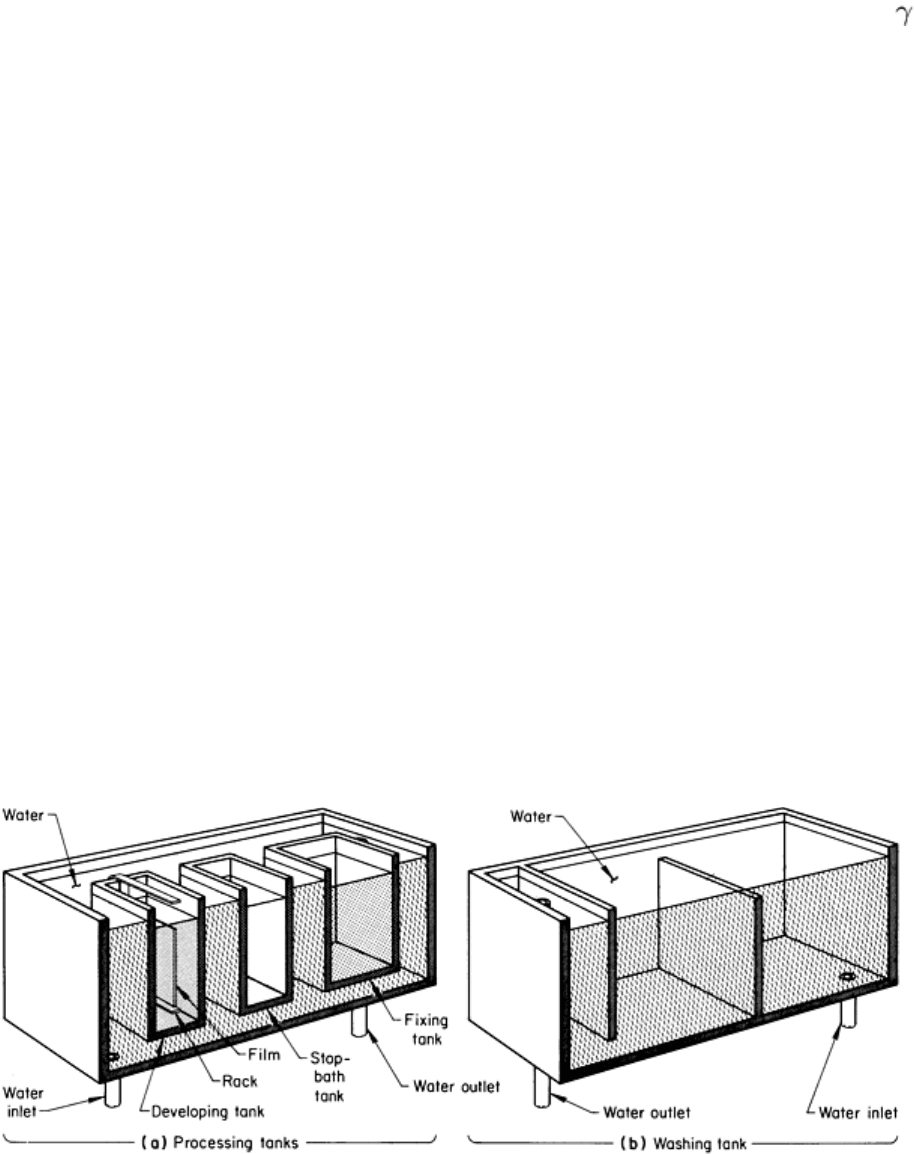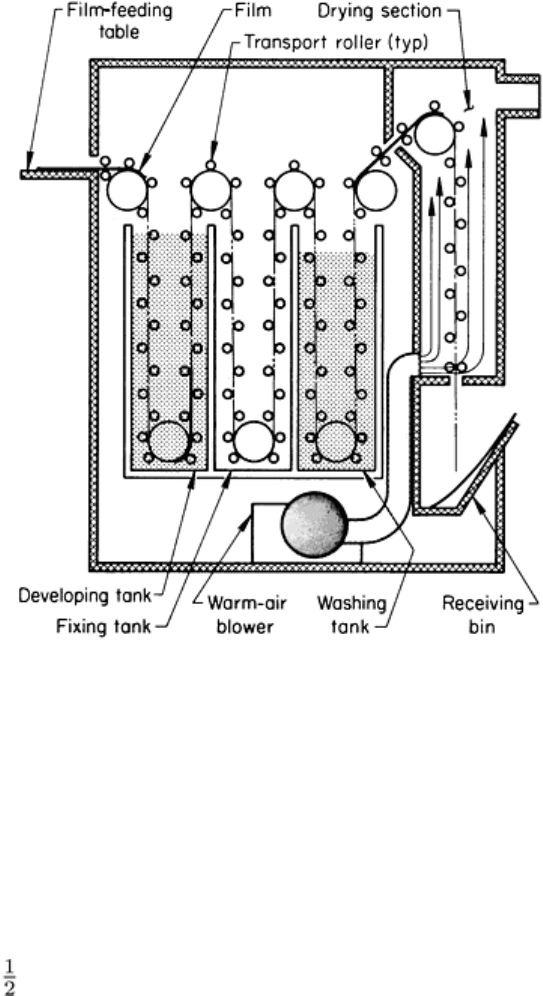ASM Metals HandBook Vol. 17 - Nondestructive Evaluation and Quality Control
Подождите немного. Документ загружается.


Appendix: Processing of Radiographic Film
In the processing of radiographic film, an invisible latent image produced on the film by exposure to x-rays, -rays, or
light is made visible and permanent. Film processing is an exacting and important part of the radiographic procedure.
Poor processing can be just as detrimental to the quality of a radiograph as poor exposure practice.
Two methods of processing can be employed: manual processing, which is carried out by hand in trays or deep tanks, and
automatic processing, which is accomplished in automated equipment. Guidelines for the control and maintenance of
manual and automatic radiographic film processing equipment are specified in ASTM E 999.
Manual Film Processing
The manual processing of radiographic film is carried out in a processing room (darkroom) under subdued light of a
particular color to which the film is relatively insensitive. The film is first immersed in a developer solution that causes
areas of the film that have been exposed to radiation to become dark; the amount of darkening for a given degree of
development depends on the degree of exposure. After development, the film is rinsed, preferably in an acid stop bath that
arrests development. Next, the film is placed in a fixing solution that dissolves the undarkened portion of the film and
hardens the emulsion. The film is subsequently washed to remove the fixing chemicals and soluble salts, then dried.
Although trays and other containers for photographic processing have been used, the usual method of processing
industrial radiographic film by hand is the rack-and-tank method. In this method, the processing solutions and wash water
are contained in tanks (Fig. 66) deep enough for the film to be hung vertically on developing hangers, or racks. The
advantages to this method are:
• Processing solutions have free access to both sides of the film
• Both emulsion surfaces are uniformly processed to the same degree
• The all-
important factor of temperature can be controlled by regulating the temperature of the water
bath in which the tanks are immersed
• The equipment does not require much space
• There is a savings in time compared to tray processing
Fig. 66 Typical unit for the manual development of radiographic film by a rack-and-
tank method. (a)
Processing tanks containing developer, stop bath, and fixer. (b) Cascade (countercurrent) washing tank
Handling of Film. The processing room and all equipment and accessories must always be kept scrupulously clean and
used only for the purpose of handling and processing film. Spilled solutions should be wiped up immediately to avoid
extraneous spots on the radiographs. Floating thermometers, film hangers, and stirring rods should be thoroughly rinsed in
clean water after each use to avoid contamination of chemicals or streaking of film.
Film and radiographs should always be handled with dry hands. Abrasion, static electricity, water, or chemical spots will
result in extraneous marks (artifacts) on the radiographs. Medicated hand creams should be avoided; rubber gloves should
be used.
Development Procedure. Prepared developers are ordinarily used to ensure a carefully compounded chemical that
gives uniform results. Commercial x-ray developers are of two types: automatic and manual. Both are comparable in
performance and effective life, but the liquids are easier to mix. Developing time for industrial x-ray films depends
mainly on type of developer. Normal developing time for all films is 8 min in a given developer at 20 °C (68 °F). More
exact tables can be obtained from the manufacturers of developers.
When exposed film is immersed in the developer solution, the chemicals penetrate the emulsion and begin to act on the
sensitized (exposed) grains in the emulsion, reducing the grains to metallic silver. The longer the development time, the
more metallic silver is formed and the blacker (more dense) the image on the film becomes.
The rate of development is heavily dependent on the temperature of the solution; the higher the temperature, the faster the
development. Conversely, if the developer temperature is low, the reaction is slow, and if the film were developed for 5
min at 16 °C (60 °F) instead of the normal 20 °C (68 °F), the resulting radiograph would be underdeveloped. Within
certain, rather narrow, temperature limits, the rate of development can be compensated for by increasing or decreasing
developing time. Exceeding these temperature limits usually gives unpredictable results.
The concept of time-temperature development should be used in all radiographic work to avoid inconsistent results. In
this concept, the temperature of the developer is always kept within a small range. The developing time is adjusted to
temperature so that the degree of development remains essentially constant. If this procedure is not followed, the results
of even the most accurate radiographic technique will be nullified.
Inspection of the film at various intervals during development under safelight conditions (called sight development)
should be avoided. It is extremely difficult to judge from the appearance of a developed but unfixed radiograph what its
appearance will be in the dry, finished state, particularly with regard to contrast. Sight development can also lead to a high
degree of fog caused by exposure to safelights during development.
A major advantage of standardized time-temperature development is that the processing procedure is essentially constant,
and an accurate evaluation of exposure time can be made. This alone can avoid many of the errors that can otherwise
occur during exposure. Increased developing time will produce greater graininess in the radiographic image, increased
film speed, and in many cases increased radiographic contrast. Although increased contrast or film speed is often
desirable, maximum recommended development times should not be exceeded.
Control of Temperature and Time. Because the temperature of the processing solutions has such a large influence
on their chemical activity, careful control of temperature--particularly of the developer--is extremely important. A major
rule in processing is to check the developer temperature before films are immersed in the developer so that the timer can
be accurately set for the correct processing time.
Ideally, the developer should be at 20 °C (68 °F). At temperatures below 16 °C (60 °F), developer action is significantly
retarded and is likely to result in underdevelopment. At temperatures exceeding 24 °C (75 °F), the radiograph may
become fogged, and the emulsion may be loosened from the base, causing permanent damage to the radiograph.
Where the water temperature in the master tanks surrounding the solution tanks may be below 20 °C (68 °F), hot and cold
water connections to a mixing valve supplying the master tank should be used. In warm environments, refrigerated or
cooled water may be necessary. Under no circumstances should ice be placed directly into the solution tanks for cooling
purposes, because melting ice will dilute, and may contaminate, the solutions. If necessary, ice can be placed in the water
bath in the master tanks for control of the solution temperature.
Control of time should be done by setting a processing timer at the time the film is immersed in the developer. The film
should be moved to the rinse step as soon as the timer alarm sounds.
Agitation During Development. A good radiograph is uniformly developed over the entire film area. Agitating the
film during the course of development is the main factor that eliminates streaking on the radiograph.

When a film is immersed vertically in the developer and is allowed to develop without movement, there is a tendency for
certain areas of the film to affect the areas directly below them. The reaction products of development have a higher
specific gravity than the developer. As these products diffuse out of the emulsion, they flow downward over the surface of
the film and affect the development of the areas over which they pass. As a result, uneven development of affected areas
forms streaks, as shown in Fig. 67. This is sometimes referred to as bromide drag. The greater the film density from
which reaction products emanate, the greater the effect on adjacent portions of the film.
Fig. 67 Streaking, or bromide drag, that can result when a film is i
mmersed in developer solution without
agitation
When the film is agitated, spent developer at the surface of the film is renewed, preventing uneven development.
Immediately after hanger and film are immersed in developer, hangers should be tapped sharply two or three times to
dislodge any air bells clinging to the emulsion. Although lateral movement of the hanger provides perhaps the best
agitation, the size and shape of the solution tanks usually limit the extent of lateral movement, thus making this type of
agitation ineffective. Vertical movement works well; it consists of lifting the hanger completely out of the solution, then
immediately replacing it in the tank two or three times at intervals of about 1 min throughout the developing time.
Agitation with stirrers or circulating pumps is not recommended. This type of agitation often produces a liquid flow
pattern that causes more uneven development than no agitation at all. Nitrogen-burst techniques, although rarely used, can
provide adequate agitation.
Activity of Developer Solution. The developing power of the solution decreases when film after film is developed,
partly because the developing agent is consumed in converting exposed silver bromide to metallic silver and partly
because of the retarding action of accumulated reaction products. The magnitude of this decrease depends on the number
of films processed and on their average size and density. Even when the developer is not used, its activity will slowly
decrease because of oxidation of the developing agent. The effect of oxidation is often apparent after as little as 1 month
of inactivity. Little can be done to control the effects of oxidation except using a lid on the developer tank. Although this
is only partly effective in preventing oxidation, it is always good practice to cover developer tanks when not in use in
order to prevent contamination.
Replenishment of Developer. If the reduction of developing action is the result of the processing of many films, it is
possible to compensate for decreased chemical activity by using a replenishment technique. When done correctly,
replenishment can maintain uniform development for a long period of time. Replenishment cannot be used to counteract
oxidation or contamination of the developer solution.
Most manufacturers of x-ray developers provide for replenishment either by supplying a separate chemical or by using the
developer mixed to a different concentration from that of the original developer solution. The correct quantity of
replenisher needed for maintaining consistent properties of the developer solution depends on the size and average density
of the radiographs being processed. For example, a dense image over the entire radiograph will use up more developing
agents and exhaust the developer to a greater degree than if the film were developed to a lower density. The quantity of
replenisher required will depend on the type of subject being radiographed; the following is provided only as a guide:
Density of radiograph
Replenisher

required
(a)
(% of background exposed)
g
oz
Low (<15%) 57
2
Medium ( 40%) 64
2
High ( 75%) 70
2
Extremely high (>90%) 78
2
(a)
Approximate quantity for each 350 × 430 mm (14 × 17 in.)
sheet of film processed
Usually, replenishers are so compounded that drainage of films back into the developer tank should be avoided. The
developer being drained is essentially spent; therefore, the developer solution in the tank is more rapidly contaminated
with reaction products when this spent solution is drained back.
A systematic procedure should be used so that a fixed quantity of developer is removed from the tank for each film that is
developed. A 350 × 430 mm (14 × 17 in.) film mounted on its hanger will normally carry with it 78 to 85 g (2 to 3 oz)
of developing solution as it is removed from the tank. Because this is approximately the amount of replenisher needed for
low-density and medium-density films, it is only necessary to replenish the developer tank to a given liquid level.
However, for high-density and extremely high-density radiographs, it would be necessary to remove and discard some of
the original developer each time replenisher is added.
If replenisher is added frequently and in small quantities, fluctuations in film density due to changes in chemical activity
of the developer will tend to even out. However, if replenisher is added infrequently, a fluctuation in film density will
become apparent, which may lead to considerable difficulty in consistently obtaining the required image quality in
successively processed radiographs. If replenishment is controlled by maintaining a specific level in the development
tank, replenisher should be added when the level of the solution drops by 6 mm ( in.).
Arresting Development. After development is completed, the action of the developer absorbed in the emulsion must
be arrested by an acetic acid stop bath or at least by prolonged rinsing in clean running water. If these steps are omitted,
the developing action continues for a short time in the fixer. This can produce uneven density or streaking on the
radiograph and will reduce the life of the acidic fixer solution because of neutralization by the alkaline developer solution.
If the smell of ammonia is detected anywhere--developer, stop bath, or fixer--the solution has become contaminated and
must be changed. When development is complete, films should be removed from the developer without draining back.
Films should remain in the stop bath for 30 s with moderate agitation before being transferred to the fixer solution. The
stop bath acts as a replenisher for the fixer, so the films can be transferred directly to the fixer without draining back into
the stop-bath solution.
If a stop bath is not used, films should be rinsed in running water for at least 2 min. If the flow of water in the rinse tank is
only moderate, the film should be agitated so that the rinse will effectively avoid streaks on the radiograph.
Fixing. The purpose of the fixer solution is to remove all of the undeveloped silver salts in the emulsion, leaving the
developed silver as a permanent image. Another important function of the fixer is to harden the gelatin of the emulsion so
that the film will be able to withstand drying in warm air and will not be tacky to the touch when it is dry and ready for
viewing. Portions of the film that have received lower amounts of radiation appear cream colored when the stop-bath
procedure has been completed. In the fixing bath, this cream color gradually disappears until it is no longer visible. The
interval of time required for this change to take place is called the clearing time. This is the time required to dissolve the
undeveloped silver halide out of the emulsion. An equal amount of time is required to allow the dissolved silver salts to
diffuse out of the emulsion and the gelatin to harden. The total fixing time, therefore, should be at least twice the clearing
time but should not exceed 15 min to avoid loss of density on the film. Films should be agitated vigorously every 2 min
during fixation to ensure uniform action of the fixing chemicals.
In performing its function, the fixer solution accumulates soluble salts, which gradually inhibits its chemical activity. As a
result of this, and possibly also because of dilution with water, the rate of fixation decreases and hardening action is
impaired in proportion to the number of films processed. The usefulness of fixer solution is ended when it loses its acidity
or when fixing requires an unusually long interval. At this point, the fixer solution must be discarded. Fixing films in
exhausted fixer frequently causes colored stains, known as dichroic fog, to appear on the radiograph. Fixer replenisher is
usually available from the manufacturer of the fixer. It is advisable not to substitute brands (or even types) of replenishers
for a given brand of fixer; the replenisher may not be compatible with the fixer.
Washing. After radiographic films have been fixed, they should be washed in running water, ensuring that the emulsion
area of the film receives frequent changes of water. Proper washing also requires that the hanger bar and top film clips be
covered completely by running water.
Effective washing of the film depends on a sufficient flow of water to rapidly carry off the fixer and to allow adequate
time for fixer chemicals to diffuse out of the film. In general, the hourly flow of water in the washing tank should be from
one to two times the volume of the tank. Under these conditions, and at water temperatures between 16 and 21 °C (60 and
70 °F), films require about 30 min of washing.
The washing tank should be large enough to wash films as quickly as possible. Too small a tank encourages insufficient
washing, which may lead to discoloration or fading of the image later when radiographs are in storage.
Drying. When films are removed from washing tanks, water droplets cling to the surface of the emulsion. If the films are
then dried rapidly, the areas under the droplets dry more slowly than surrounding areas. Such uneven drying causes
distortion of the gelatin, changing the density of the image. Uneven drying often results in visible spots on the finished
radiograph that interfere with accurate interpretation.
Water spots usually can be prevented by immersing washed films for 1 to 2 min in a wetting-agent solution and allowing
them to drain for a few minutes before placing them in a drier. This procedure permits surplus water to drain off of the
film more evenly, significantly reducing drying time and the likelihood that the finished radiograph will exhibit water
spots.
It is important to use wetting agents that are compatible with x-ray film emulsions. Some commercial wetting agents are
not compatible with film and therefore should not be used.
If only a few radiographs are processed daily, racks that allow the film to be air dried under room conditions of
temperature and humidity can be used, although this method of drying requires considerable time. To avoid spots on the
radiographs, the racks that hold the film hangers should be positioned so that films do not touch each other, and water
should not be splashed on drying films. Radiographs dry best in constantly changing warm dry air.
The fastest way to dry films is in commercial film driers. These driers incorporate fans and heaters, and some driers use
chemical desiccants to remove water from the air.
Regardless of the method of drying, a radiograph is considered dry when the film is dry under the hanger clips. When this
stage is reached, the hangers are removed from the drier or rack, and the film is carefully removed from the hanger for
interpretation.

In manual processing, when the film is clipped to the hanger, pins in the hanger clip penetrate the film and leave sharp
projections in the corners of the film. It is usually desirable to cut off the corners containing these clip marks to prevent
scratching of other radiographs during handling and reading.
Automatic Film Processing
Although expertly done manual processing is difficult to surpass, it is equally difficult to maintain because of human
factors. Automatic processing, which accurately controls temperature, time, agitation, and replenishment, delivers a dry
radiograph in a short time. In addition to the advantage of shorter processing time, automatic processing can ensure that
variability of time, temperature, and activity of the solutions is eliminated.
Many automatic processors incorporate a roller-transport mechanism that carries the film itself through the entire process
cycle without the need for hangers. Figure 68 illustrates a typical automatic processor that incorporates a roller-transport
mechanism.
Fig. 68 Cross section of an automatic film processor showing roller-
transport mechanism and locations of
components
Automatic processing is a carefully controlled system in which the film, processing chemicals and their replenishment,
temperature of solutions, travel speed of the roller-transport mechanism, and drying conditions all work together for
consistent development of latent images. The advantages of roller-type automatic processors are:
• Rapid processing of radiographs: Depending on many variables, particularly the kind of ra
diographic
film and the type of processing chemicals, the elapsed time from exposed film to finished radiograph
can be as short as 4 min and usu
ally not more than 15 min. This represents a savings of at least 45 min
compared to manual processing
• Uniformity of radiographs:
Most automatic processors carefully control the time and temperature of
processing. Combined with accurate automatic replenish
ment of solutions and constant agitation of the
film as it travels through the processor, accurate time-temperature control produces day-to-
day
consistency and freedom from processing artifacts seldom achieved in manual processing. Because
processing variables are virtually eliminated, optimum exposure techniques can be established
• Conservation of space: Most models of automatic processors require no more than 1 m
2
(10 ft
2
) of floor
space. Some models can even be installed on a workbench. This means that h
and tanks and drying
facilities can be eliminated from the processing room. All that is needed is a bench for loading and
unloading of film, film-
storage facilities, and a small open area in front of the processor feed tray. Most
processors are installed s
o that the film is fed from the processing room (darkroom) and emerges as a
complete radiograph in the adjacent room
Automatic processors contain a developing tank, a fixing tank, a washing tank, and a drying section (Fig. 68). The stop-
bath and wetting-agent tanks are eliminated because automatic processors have squeegee rollers at the exit of each tank
that reduce retention of residual solution by the film to a minimum, and minor solution contamination of the fixer is
corrected by replenishment. The rollers at the exit of the fixer reduce the amount of residual fixer to only that absorbed in
the emulsion as the film enters the wash cycle. Therefore, the running wash water is virtually free of fixer chemicals.
Finally, the exit rollers of the wash tank squeeze wash water from the film, so that the film enters the drier in almost a
damp-dry condition.
Processing chemicals must be specially formulated for automatic processors. The developer must operate at higher
temperatures than for manual processing and usually contains a hardening agent to condition the emulsion so that the film
can be moved by the roller transport system without slippage. The fixer is also specially formulated to fix the emulsion in
a relatively short time at higher temperatures than for manual processing and to condition the film for proper drying. It
should be noted that developers and fixers formulated for manual processing usually are not suitable for automatic
processing.
Replenishment of Developer and Fixer. In an automatic processor, replenishment of developer and fixer is
automatically controlled. An adjustable, positive-metering device controls both developer and fixer; sometimes separate
metering devices are used for developer and fixer. Usually, the replenisher pump is activated when the leading edge of the
film enters a film sensor in the processor and continues to pump until the trailing edge of the film passes these rollers.
Thus, the amount of replenishment is controlled by the length of film passing through the entrance rollers.
Replenishment rates for developer and fixer are normally supplied by film manufacturers. Obviously, these are only
guidelines because if radiographs are routinely of higher or lower densities than the average on which the manufacturer's
recommendations are based, the replenishment rate may have to be adjusted upward and downward for optimum results.
The procedure for checking replenishment rates and frequency of replenishment is given in the operator's manual for the
processor. The accuracy of replenishment is important. Too little or too much replenishment can adversely affect film
densities, lead to transport difficulties, reduce processing uniformity, and shorten the useful life of the processing
solutions.
Film-Feeding Procedures. Because replenisher pumps are controlled by the length of film fed into the processor, it is
obvious that feeding single, narrow-width films will cause excessive replenishment. Therefore, whenever possible,
narrower films should be fed side by side. Films should be fed into the processor parallel to the side of the feed tray.
Multiple films should have a space between them to avoid overlapping and should be started together into the processor to
avoid excessive replenishment.
Three rolls of the roller-transport system must always be in contact with the film to maintain proper travel through the
processor. Thus, there is a lower limit to the length of film to be processed. Although this depends on roller diameter and
spacing, the usual lower limit is about 125 mm (5 in.).
In general, roll films having widths from 16 to 430 mm (0.6 to 17 in.) can be processed in most automatic processors. The
processing of roll films requires a somewhat different procedure than for sheet film. Because roll film is wound on spools,
it frequently has an inherent curl that can cause the film to wander out of the roller system. To avoid wandering, a sheet of
leader film can be attached to the leading edge of the roll. Ideally, the leader should be unprocessed radiographic film,
preferably wider than the roll being processed and at least 250 mm (10 in.) long. The leader may be attached to the roll by
means of pressure-sensitive polyester tape about 25 mm (1 in.) wide. Suitable types of tape must be composed of

materials that are not soluble in the solutions. To avoid transport problems, care must be taken that adhesive from the tape
does not come in contact with the rollers.
It is important to feed narrow widths of roll film parallel to the edge of the feed tray. If quantities of such film are
normally processed, it is usually advisable to provide a guide in the feed tray to make sure each film is parallel to the
others and to the sides of the tray. If this is not done, there is a possibility of the films overlapping somewhere in the
transport systems.
If only one long roll of narrow film is to be processed, the replenisher pumps will keep running and the result may be
excessive replenishment. To avoid this, replenisher pumps should be turned off for a portion of the feed time.
Preventive Maintenance. Most of the downtime and other problems related to the operation of automatic processors
stem from the lack of maintenance. Service problems can be minimized by well-established maintenance of the processor
and by good housekeeping. Each processor manufacturer recommends daily and weekly cleanup procedures that take
only a few minutes to perform. These procedures, usually available in the form of check lists, are necessary for reliable
operation of the processor and for production of radiographs of optimum quality.
Precautions. Automatic processing is a system in which the film, chemical, and processing equipment all have to work
together for optimum processing. For example, if radiographs leave the processor wet, it could well be an indication of a
problem with one of the chemicals and not the result of incorrect drying temperature.
Some films can be successfully processed more rapidly than others. However, changing the speed of the processor to a
value other than that for which the processor was designed can unbalance the system and require adjustments in film
characteristics, replenishment rates, temperatures, and perhaps other conditions in order to restore optimum processing
quality. Care must be taken that the storage life of the radiograph is not impaired by changes in the processor. Table 14
lists some typical problems with automatic film processing.
Table 14 Probable causes and corrective action for various types of deficient image quality or artifacts from
automatic film processing
See Table 12 for factors not specifically associated with automatic film processing.
Quality or artifact Probable cause
Problem and corrective action
Developer temperature too high: Follow temperature recommendations
for developer and processor used. Check temperature of incoming
water. Check accuracy of thermometers used.
Density too high Overdevelopment
Improperly mixed chemicals: Follow instructions for preparations of
solutions.
Improper replenishment of developer: Check for clogged strainers or
pinched tubing in developer replenishment system.
Underdevelopment
Developer temperature too low: Follow temperature recommendations
for developer and processor used. Check temperature of incoming
water. Check accuracy of thermometers used.
Density too low
Contamination
Fixer in developer tanks: Use extreme care when installing or removing
fixer rack in processor. Always use splash guard when fixer rack is
being removed or replaced. Do not exchange racks between fixer and
developer compartments.
Contrast too low Underdevelopment
See Underdevelopment above.

Contamination
See Contamination above.
Fog Overdevelopment
Developer temperature too high: Follow temperature recommendations
for developer and processor used. Check temperature of incoming
water. Check accuracy of thermometers used.
Underreplenishment of solutions (particularly fixer): Check for clogged
strainers or pinched tubing in replenishment system.
Poor drying Processing
Inadequate washing: Check flow of wash water.
Drying Dryer temperature too low: Follow
recommendations for film type and
processor involved.
Associated with tempo of work
Long interval between feeding of films: "Delay streaks" (uneven streaks
in direction of film travel) caused by interval of 15 min or more in
feeding of successive films, which results in drying of solutions on
processor rollers exposed to air. Wipe down exposed rollers with damp
cloth. Process unexposed 14 × 17 film before processing radiograph.
(Some processors are equipped with "rewet rollers" which prevent
delay streaks.)
Associated with development
Clogged developer recirculation system: Change filter cartridge
regularly. Check recirculation pump. (This defect is associated with a
rapid rise in developer temperature.)
Dirty tubes in dryer: (Causes regular streaks, visible by reflected light
only.) Clean dryer tubes.
Streaks
Associated with dryer
High dryer temperature: (Causes irregular streaks or blotches, visible
by reflected light only.) Reduce temperature to recommended value.
Guide marks
(regularly spaced
scratches or high
density lines)
Improperly adjusted guides in
processor
Check clearances between guide devices and adjacent rollers or other
components
Roller abrasions
(random fine lines
in the direction of
film travel)
Stopped or hesitating rollers
Be sure all rollers are in their proper positions, and that end play is
sufficient for rollers to turn freely.
Random scratches
and spots
Dirt on feed tray
Clean processor feed tray frequently with soft cloth. If the atmosphere
is dirty, the processing room should be fed with filtered air and kept at
a pressure above that outside.
Irregular deposit
(often light in color,
generally elongated
in direction of film
Caused by dirt or precipitate in
water supplied to washing section.
If condition is temporary, clean wash rack and replace wash water in
processor; drain wash tank when shutting processor down. If
condition persists, use filters in incoming water lines. (Some dirt
deposits can be removed from the dry radiograph by gentle rubbing

travel)
with dry cotton or a soft cloth.)
Pressure marks caused by build-up
of foreign matter on rollers or by
improper roller clearances, usually
in developer section.
Clean rollers thoroughly and maintain proper clearances.
"Black comets" with tails extending
in direction of film travel caused by
rust or other iron particles dropping
on film, usually at entrance
assembly.
Clean all entrance assembly components. Apply a light coat of grease
to microswitch springs and terminals. If air contains iron-bearing
dust, filter air supply to processing room.
Dark lines and
spots
"Pi lines." (So called because they
occur 3.14 times the diameter of a
roller away from the leading edge
of a film.)
Most common in newly-installed or freshly cleaned processors. Tends
to disappear with use of processor. (Some processors are equipped
with buffer rollers at the exit of the wash rack, which remove the
deposit before the radiograph enters the dryer.)
Tests for Removal of Fixer
If radiographic films are not properly washed, fixer chemicals (largely thiosulfate salts) remain in the emulsion and affect
the storage life of the radiographs. Radiographs intended for storage of 3 to 10 years are usually referred to as having
commercial quality. Those to be kept for 20 years or more are known as having archival quality. Archival quality is of
considerable importance in complying with certain codes, standards, and specifications. If residual thiosulfate in the
radiographs exceeds a certain maximum allowable level, the radiograph is likely to become useless because of fading or a
change in color during long-term storage.
The American National Standards Institute has three important documents relating to this problem: ANSI PH 4.8 (1985),
ANSI PH 1.41 (1984), and ANSI PH 1.66 (1985).
The first document (ANSI PH 4.8) describes two methods of determining residual thiosulfate in radiographs. Both of
these are laboratory procedures for evaluating unexposed but processed (clear) areas of a radiograph. The methylene blue
test must be performed within two weeks of processing the film, but the silver densitometric test can be performed at any
time after processing. The second document (ANSI PH 1.41) specifies, among other things, the maximum level of
thiosulfate in grams per unit area for archival storage. The third document (ANSI PH 1.66) gives other helpful
recommendations for storage of radiographs. Procedures given in all three ANSI documents are accepted as valid
procedures by most codes, standards, and specifications.
There are other tests that are easier to perform than those described in ANSI PH 4.8, but they indicate more than the
residual level of thiosulfate and therefore are considered only estimates rather than accurate determinations. In one test, a
solution is made of 710 mL (24 oz) of water, 120 mL (4 oz) of acetic acid (28%), and 7 mL ( oz) of silver nitrate and
diluted with 950 mL (32 oz) of water prior to use. When a drop of the diluted solution is placed on a clear area of a
radiograph, it turns brown. The amount of residual fixer chemicals is estimated by matching the brown spot on the film
with one of the patches on a standard test strip. Several manufacturers produce estimating kits, but for accurate
determination of residual thiosulfate it is necessary to perform either the methylene blue test or the silver densitometric
test described in ANSI PH 4.8.
Microfilming of Radiographs
The microfilming of radiographs has recently been implemented on a commercial basis for the storage of industrial
radiographs, and it has been in use for some time in the medical field. The microreduction of radiographs has been
successfully performed by the commercial nuclear power plant industry as a solution to problems associated with
radiographic film deterioration, large-volume archival storage, and general records management.
Because of improper initial processing or failure to store and handle processed film using sound practices, radiographs are
subject to deterioration or degradation. Specific examples of improper processing include:
